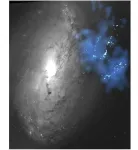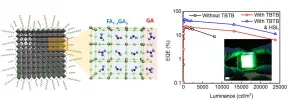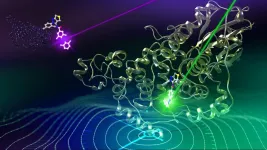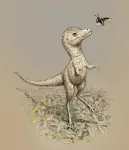New galaxy sheds light on how stars form
Detailed observations of molecular gas in a tidal dwarf galaxy have important implications for our understanding of how stars are formed
2021-01-25
(Press-News.org) A lot is known about galaxies. We know, for instance, that the stars within them are shaped from a blend of old star dust and molecules suspended in gas. What remains a mystery, however, is the process that leads to these simple elements being pulled together to form a new star.
But now an international team of scientists, including astrophysicists from the University of Bath in the UK and the National Astronomical Observatory (OAN) in Madrid, Spain have taken a significant step towards understanding how a galaxy's gaseous content becomes organised into a new generation of stars.
Their findings have important implications for our understanding of how stars formed during the early days of the universe, when galaxy collisions were frequent and dramatic, and star and galaxy formation occurred more actively than it does now.
For this study, the researchers used the Chile-based Atacama Large Millimeter Array (ALMA) - a network of radio telescopes combined to form one, mega telescope - to observe a type of galaxy called a tidal dwarf galaxy (TDG). TDGs emerge from the debris of two older galaxies colliding with great force. They are actively star-forming systems and pristine environments for scientists trying to piece together the early days of other galaxies, including our own - the Milky Way (thought to be 13.6-billion years old).
"The little galaxy we've been studying was born in a violent, gas-rich galactic collision and offers us a unique laboratory to study the physics of star formation in extreme environments," said co-author Professor Carole Mundell, head of Astrophysics at the University of Bath.
From their observations, the researchers learnt that a TDG's molecular clouds are similar to those found in the Milky Way, both in terms of size and content. This suggests there is a universal star-formation process at play throughout the universe.
Unexpectedly, however, the TDG in the study (labelled TDG J1023+1952) also displayed a profusion of dispersed gas. In the Milky Way, clouds of gas are by far the most prominent star-forming factories.
"The fact that molecular gas appears in both cloud form and as diffuse gas was a surprise," said Professor Mundell.
Dr Miguel Querejeta from the OAN in Spain and lead author of the study added: "ALMA's observations were made with great precision so we can say with confidence that the contribution of diffuse gas is much higher in the tidal dwarf galaxy we studied than typically found in normal galaxies."
He added: "This most likely means most of the molecular gas in this tidal dwarf galaxy is not involved in forming stars, which questions popular assumptions about star formation."
Because of the vast distance that separates Earth from TDG J1023+1952 (around 50 million light years), individual clouds of molecular gas appear as tiny regions in the sky when viewed through the naked eye. However, ALMA has the power to distinguish the smallest details.
"We have managed to identify clouds with an apparent size as small as observing a coin placed several kilometres away from us," said Professor Mundell, adding: "It's remarkable that we can now study stars and the gas clouds from which they are formed in a violent extragalactic collision with the same detail that we can study those forming in the calm environment of our own Milky Way."
INFORMATION:
The paper ALMA Resolves Giant Molecular Clouds in a Tidal Dwarf Galaxy appears in the latest issue of Astronomy & Astrophysics. This research was a collaborative effort of scientists from across the world working remotely. Their expertise covers the physics of stars, dust and gas, and the science of galaxy evolution.
[Attachments] See images for this press release:

ELSE PRESS RELEASES FROM THIS DATE:
2021-01-25
Children of mothers experiencing depressive symptoms are more at risk, as adolescents, of experiencing suicidal thoughts and attempting suicide.
New research suggests that this link may be explained by loneliness, potentially opening new ways for youth suicide prevention.
The study - by the universities of Exeter, Montréal, Laval and McGill - used data from more than 1,600 families from the Québec Longitudinal Study of Child Development, a representative sample of new-borns in Quebec followed from birth to 20 years of age.
Mothers were asked about depressive symptoms (such as sadness and losing interest ...
2021-01-25
As the world becomes aware of the imminent environmental crisis, scientists have begun a search for sustainable energy sources. Rechargeable batteries like lithium-ion batteries are seeing a popularity surge, concurrent with production of "greener" technologies such as electric propulsion ships (which are being developed to meet the environmental regulations by the International Maritime Organization) and other electric vehicles. But, lithium is rare and difficult to distribute, putting its sustainability in doubt while also risking sharp increases in cost. Researchers have thus turned ...
2021-01-25
To predict when earthquakes are likely to occur, seismologists often use statistics to monitor how clusters of seismic activity evolve over time. However, this approach often fails to anticipate the time and magnitude of large-scale earthquakes, leading to dangerous oversights in current early-warning systems. For decades, studies outside the seismology field have proposed that these major, potentially devastating seismic events are connected to a range of non-seismic phenomena - which can be observed days or even weeks before these large earthquakes occur. So far, however, this idea hasn't caught on in the wider scientific community. In this special issue, EPJ Special Topics proposes the Global Earthquake Forecasting System (GEFS): the first collaborative initiative ...
2021-01-25
Scientists have shown where bird species would exist in the absence of human activity under research that could provide a new approach to setting conservation priorities.
A study by Durham University, UK, in collaboration with the Royal Society for the Protection of Birds (RSPB), investigated how human activities such as agriculture, deforestation, and the drainage of wetlands have shaped where bird species are found in Great Britain today.
Researchers used data on the geographical distributions of bird species alongside simulation models to predict where bird species would exist today if the effects of human activities on the landscape were removed.
In this scenario there were winners ...
2021-01-25
Public health researchers, led by UNSW Sydney, have estimated the number of cancer cases requiring surgery globally each year, predicting the number will rise from 9.1 million to 13.8 million from 2018 to 2040 - an increase of 52 per cent or 4.7 million cases.
Their research shows the greatest relative increase will occur in 34 low-income countries, where the number of cases requiring surgery is expected to more than double by 2040 (314,355 cases to 650,164, or 107 per cent).
The modelling study, published in The Lancet Oncology on Friday, analysed global demand for cancer surgery and estimated surgical and anaesthesia ...
2021-01-25
Research team at Seoul National University (Prof. Tae-Woo Lee) and University of Pennsylvania (Prof. Andrew M. Rappe) developed perovskite light-emitting diodes (PeLEDs) with an external quantum efficiency (EQE) of 23.4%. The research results were published in Nature Photonics, which is the world-renowned international academic journal, on January 4th (Title: Comprehensive defect suppression in perovskite nanocrystals for high-efficiency light-emitting diodes).
Metal halide perovskites have very narrow spectral emission, excellent color purity, low material cost, and wide and easy color-tunability. ...
2021-01-25
The Nagoya University Institute of Transformative Bio-Molecules (WPI-ITbM) research team of Designated Associate Professor Tsuyoshi Hirota, Postdoctoral Fellow Simon Miller, Professor Kenichiro Itami and graduate student Tsuyoshi Oshima (Research Fellowship for Young Scientists, JSPS), in collaboration with the group of Professor Ben Feringa and Postdoctoral Fellow Dušan Kolarski of Groningen University in the Netherlands, have achieved a world first: fully reversible manipulation of the period of the circadian clock using light, by exchanging part of a compound with a light-activated switch.
Waking in the ...
2021-01-25
Greater sports participation among Aboriginal and Torres Strait Islander children is linked with better academic performance, according to new research from the University of South Australia.
Conducted in partnership with the University of Sydney and the University of Technology Sydney, the world-first study found that Aboriginal and Torres Strait Islander children who played organised sports every year over four years, had numeracy skills which were advanced by seven months, compared to children who did less sport.
The study used data from four successive waves of Australia's Longitudinal Study of Indigenous Children, following 303 students (with a baseline age of five to six years old) to assess cumulative sports participation against ...
2021-01-25
A world-first discovery by researchers at Monash University and The University of Queensland could lead to faster and more effective treatments for chronic health complications, such as cardiovascular disease and cancer, with 'fluorescent' in vivo biosensors.
The research team, led by Dr Simon Corrie from Monash University's Department of Chemical Engineering and the ARC Centre of Excellence in Convergent Bio-Nano Science and Technology, took an antibody that binds EGFR (epidermal growth factor receptor) proteins and engineered it to monitor the concentration of EGFR proteins in serum solutions over time.
Co-authors of the paper, published in ACS Sensors, are Dr Christian Fercher, Dr Martina ...
2021-01-25
They are among the largest predators ever to walk the Earth, but experts have discovered that some baby tyrannosaurs were only the size of a Border Collie dog when they took their first steps.
The first-known fossils of tyrannosaur embryos have shed light on the early development of the colossal animals, which could grow to 40 feet in length and weigh eight tonnes.
A team of palaeontologists, led by a University of Edinburgh researcher, made the discovery by examining the fossilised remains of a tiny jaw bone and claw unearthed in Canada and the US.
Producing 3D scans of the delicate fragments revealed that they belonged to baby tyrannosaurs ...
LAST 30 PRESS RELEASES:
[Press-News.org] New galaxy sheds light on how stars form
Detailed observations of molecular gas in a tidal dwarf galaxy have important implications for our understanding of how stars are formed






